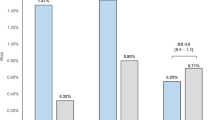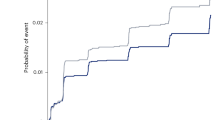Abstract
The purpose of this double-blind, randomised trial with a 4-week placebo run-in period followed by an active treatment period using either spirapril 3 mg or 6 mg once a day was to clarify the existence of hypotensive episodes in elderly hypertensive patients treated by an ACE-inhibitor. Forty hypertensive patients aged 60–76 years underwent 24-h ABPM at the end of the run-in (week 4) and active treatment (week 9) periods. The mean 24-h systolic blood pressure (SBP) decreased from 161.9 (26.7) mm Hg to 150.6 (29.9) mm Hg (P < 0.001) and diastolic blood pressure (DBP) from 91.70 (14.7) mm Hg to 84.2 (17.3) mm Hg (P < 0.001). No episodes of mean arterial pressure (MAP) <50 mm Hg were seen during the placebo period. Instead 11 episodes were observed during the antihypertensive treatment (one in the 3 mg group and 10 in the 6 mg group, P < 0.01 between the two treatment groups). Fifty-four episodes of MAP <70 mm Hg were observed during the placebo period and 117 during the treatment period (P < 0.001). During the placebo period low MAPs were observed only during night time. During the treatment period they were seen also from 11 am to 4 pm. In conclusion, ACE-inhibitor therapy with spirapril significantly increased hypotensive episodes in elderly hypertensive patients which may worsen their cerebral and myocardial circulation
This is a preview of subscription content, access via your institution
Access options
Subscribe to this journal
Receive 12 digital issues and online access to articles
$119.00 per year
only $9.92 per issue
Buy this article
- Purchase on Springer Link
- Instant access to full article PDF
Prices may be subject to local taxes which are calculated during checkout
Similar content being viewed by others
References
Strandgaard S Autoregulation of cerebral blood flow in hypertensivepatients. The modifying influence of prolonged antihypertensive treatment on the tolerance to acute, drug-induced hypotension Circulation 1976 53 720–727
Kario K et alNocturnal fall of blood pressure and silent cerebrovascular damage in elderly hypertensivepatients Hypertension 1996 27 130–135
Harrison DG et alThe effect of hypertension and left ventricular hypertrophy on the lower range of coronary autoregulation Circulation 1988 77 1108–1115
Mansour et alLow blood pressure levels and signs of myocardial ischaemia: importance of left ventricular hypertrophy J Hum Hypertens 1993 7 13–18
Bostrom PA et alBlood pressure and myocardial perfusion in hypertensivepatients with and without left ventricular hypertrophy J Hum Hypertens 1995 9 969–974
Pierdomenico SD et alCircadian blood pressure changes and myocardial ischemia in hypertensivepatients with coronary artery disease J Am Coll Cardiol 1998 31 1627–1634
Shuaib A Alteration of blood pressure regulation and cerebrovascular disorders in the elderly Cerebrovasc Brain Metab Rev 1992 4 329–345
Gosse P, Promax H, Durandet P, Clementy J White coat hypertension. No harm for the heart Hypertension 1993 22 766–770
Taylor R et alAccutracker II (version 30/23) ambulatory blood pressure monitor: clinical validation using the British Hypertension Society and Association for the Advancement of Medical Instrumentation standards J Hypertens 1993 11 1275–1282
White W Analysis of ambulatory blood pressure data in antihypertensive drug trials J Hypertens 1991 9 (Suppl 1) S27–S32
Edvinsson L, MacKenzie E, McCulloch J Disturbed cerebral autoregulation. In: Edvinsson L, MacKenzie E, McCulloch J (eds) Cerebral Blood Flow and Metabolism Raven Press: New York 1993 599–609
Folkow B The haemodynamic consequences of adaptive structural changes in the resistance vessels in hypertension Clin Sci 1971 41 1–12
Barry DI et alEffects of captopril on cerebral blood flow in normotensive and hypertensive rats Am J Med 1984 76 79–85
Pedersen EV, Bobkiewicz-Kozlowska T, Waldemar G, Barry DI The renin angiotensin of cerebral arteries contributes to cerebrovascular resistance Eur J Clin Invest 1987 17 A38
Rajagopalan B, Raine AEG, Cooper R, Ledingham JGG Changes in cerebral blood flow inpatients with severe congestive cardiac failure before and after captopril treatment Am J Med 1984 76 86–90
Kincaid-Smith P, McMichael J, Murphy EA The clinical course and pathology of hypertension with papilloedema (malignant hypertension) Quart J Med New Series 1958 27 117–153
Barry DI Cerebrovascular aspects of antihypertensive treatment Am J Cardiol 1989 63 14C–18C
Polese A et alUpward shift of the lower range of coronary autoregulation in hypertensivepatients with hypertrophy of the left ventricle Circulation 1991 83 845–853
Flora JS Antihypertensive treatment, myocardial infarction, and nocturnal myocardial ischemia Lancet 1989 2 251–254
Kuriyama Y, Nakamura M, Kyougoku I, Sawada T Effects of carvedilol on cerebral blood flow and its autoregulation in previous strokepatients Eur J Clin Pharmacol 1990 38 (Suppl 2) 120–121
Graettinger W, Lipson J, Cheung D, Weber M Validation of portable blood pressure monitoring devices: comparison with intra-arterial and sphygmomanometer measurements Am Heart J 1988 116 1155–1160
Berardi L et alAmbulatory blood pressure monitoring: a critical review of the current methods to handle outliers J Hypertens 1992 10 1243–1248
White W, Lund-Johanssen P, Omvik P Assessment of four ambulatory blood pressure monitors and measurements by clinicians versus intra-arterial blood pressure at rest and during exercise Am J Cardiol 1990 65 60–66
Hansson Let al,for the HOT Study GroupEffects of intensive blood-pressure lowering and low-dose aspirin inpatients with hypertension: principal results of the Hypertension Optimal Treatment (HOT) randomised trial Lancet 1998 351 1755–1762
MacMahon S, Rodgers A The effects of blood pressure reduction in olderpatients: an overview of five randomized controlled trials in elderly hypertensives Clin Exp Hypertens 1993 15 967–978
Hayreh SS, Zimmerman MB, Podhajsky P, Alward WL Nocturnal arterial hypotension and its role in optic nerve head and ocular ischemic disorders Am J Opthalmol 1994 117 603–624
Lassen NA Cerebral blood flow and oxygen consumption in man Phys Rev 1959 39 138–238
Wasserman AJ, Patterson JL The cerebral vascular response to reduction in arterial cardon dioxide tension J Clin Invest 1961 40 1297–1303
Strandgaard S, Paulson OB Cerebrovascular consequences of hypertension Lancet 1994 344 519–521
Acknowledgements
This study was supported by Novartis Ltd, Basel, Switzerland and Novartis Finland, Espoo, Finland.
Author information
Authors and Affiliations
Corresponding author
Rights and permissions
About this article
Cite this article
Kantola, I., Terént, A., Kataja, M. et al. ACE-inhibitor therapy with spirapril increases nocturnal hypotensive episodes in elderly hypertensive patients. J Hum Hypertens 15, 873–878 (2001). https://doi.org/10.1038/sj.jhh.1001285
Received:
Revised:
Accepted:
Issue Date:
DOI: https://doi.org/10.1038/sj.jhh.1001285



